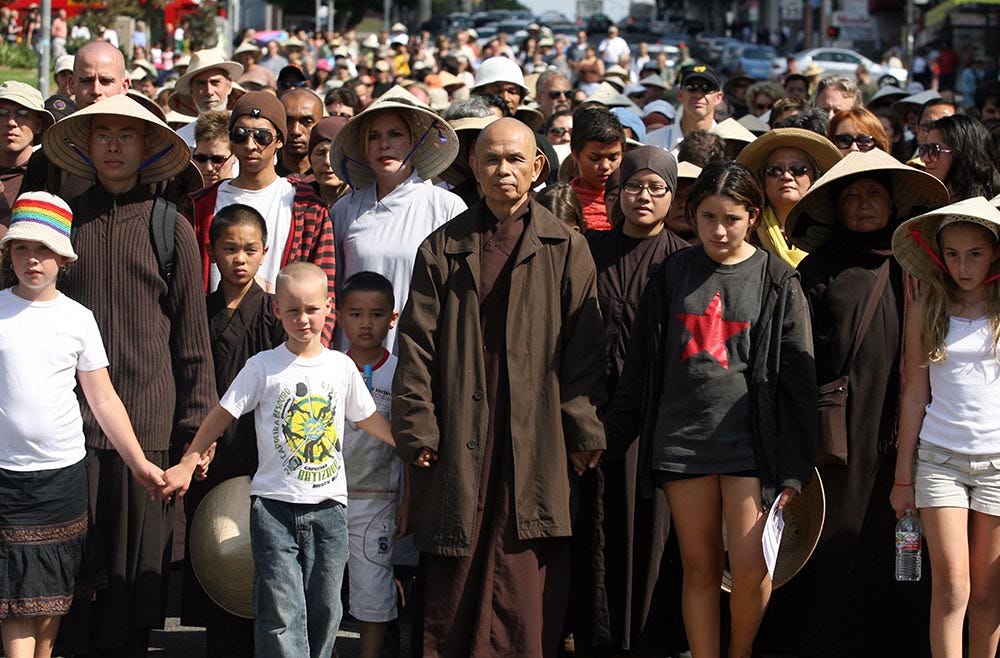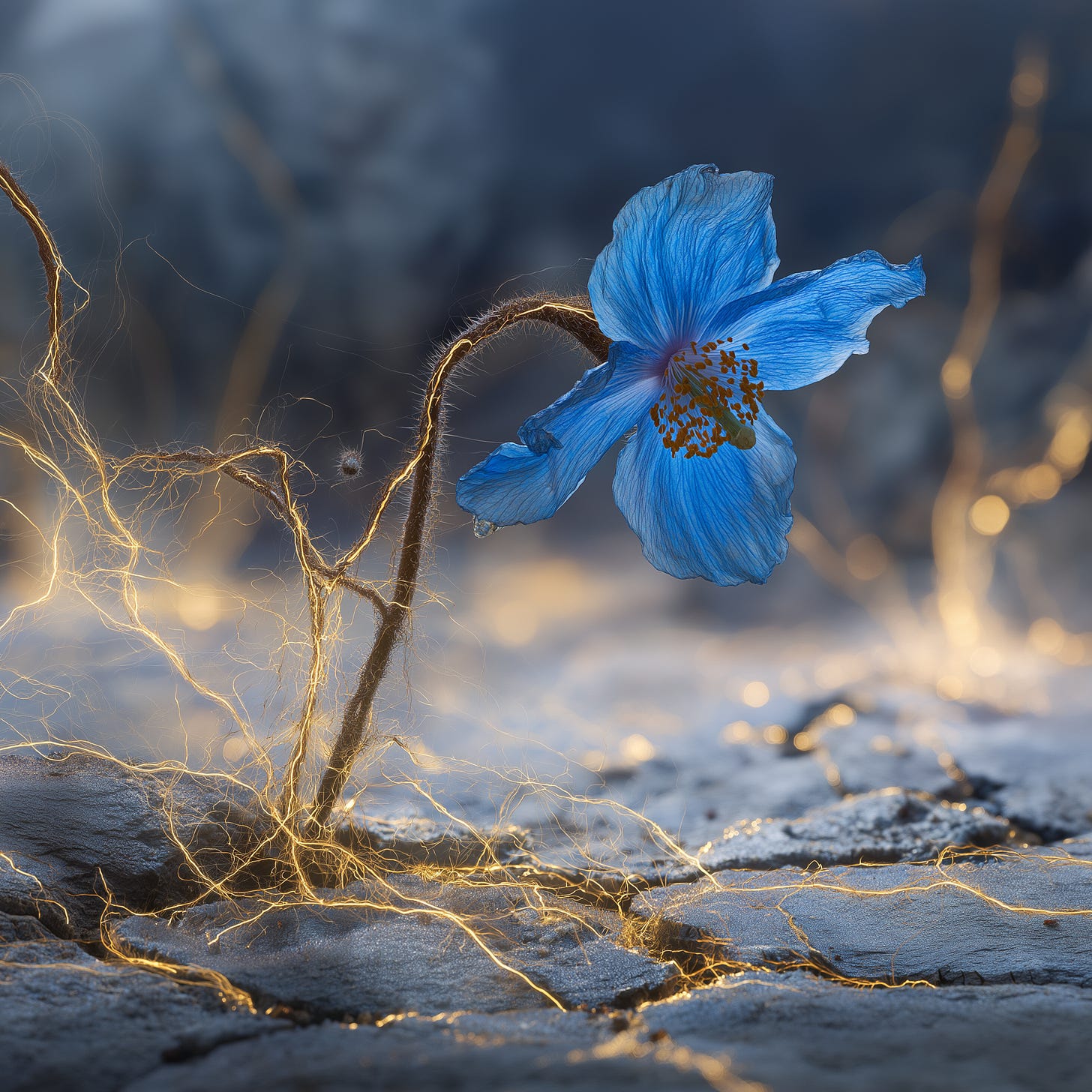The Hidden Seed
Why Buddha-Nature Matters When the World Is Breaking
In the Himalayas, there grows a flower called the Meconopsis betonicifolia, the blue poppy. For decades, sometimes centuries, its seeds lie dormant beneath frozen soil. They wait through avalanches, through the footfalls of yaks, through seasons when nothing seems possible. Then, in some unremarkable spring, triggered by conditions no one fully understands, they bloom.
Electric blue against the snow. Impossible, yet there.
The Buddha, sitting beneath the bodhi tree twenty-five hundred years ago, saw something similar in us. Not metaphorically. Literally. He called it Tathāgatagarbha—the womb of the thus-gone one, often translated as the Buddha-nature. Every sentient being, he insisted, carries this seed of awakening. Not some beings. Not the good ones. All beings.
Right now, in this particular moment of history, when algorithms sort us into opposing camps before breakfast, when the very climate seems to mirror our collective fever, this ancient teaching has acquired a peculiar urgency. It’s not that Buddha-nature has become more relevant; it’s that our forgetting of it has become more dangerous.
Consider what happens when you walk through a city and see only competitors, threats, obstacles. The nervous system, that ancient equipment we share with lizards, floods with cortisol. The world shrinks to the size of your fear. Now consider what happens when you remember, even for a moment, that the irritable barista, the politician you despise, the neighbor with the awful opinions, each carries the same fundamental capacity for awakening that you do. The body softens. Space opens. Not because you’ve gone soft or naive, but because you’ve remembered something true.
This is not optimism. Optimism says things will get better. Buddha-nature says things are already complete, just hidden.
The distinction matters.
In Myanmar, Buddhist monks have blessed soldiers committing genocide. In Silicon Valley, meditation apps promise to optimize your productivity while the world burns. These are not failures of Buddhism but failures to understand what Buddha-nature actually means. It is not a hall pass for cruelty. It is not spiritual bypassing dressed in saffron robes. To see Buddha-nature is to see clearly, including the very real suffering, the very real systems of oppression, the very real damage we do to each other.
The Zen teacher Bernie Glassman used to take his students to bear witness at Auschwitz. Not to pray, particularly. Not to forgive. Just to sit with the unbearable reality of what humans can do to each other. And then, in that darkness, to remember: even the guards had Buddha-nature. Even the commandants. This is not absolution. It’s the opposite; it’s the recognition that makes evil truly unbearable. Every act of cruelty is a betrayal of what we fundamentally are.
Here’s what happens when you begin to perceive Buddha-nature: the world becomes more vivid, not less. Anger still arises, but it’s clear anger, unclouded by the story that some people are fundamentally different from you. You can fight injustice more effectively when you’re not wasting energy on hatred. Ask any skilled martial artist: the moment you make your opponent into a monster, you’ve already lost. You’ve abandoned your center for a story.
The mycologist Paul Stamets discovered that forests communicate through fungal networks, vast underground webs that connect tree to tree, species to species. A Douglas fir can nurture a hemlock seedling through these networks. A dying tree can dump its resources into the collective system. The forest reminds us of what we keep forgetting: separation is a temporary illusion. Connection is the baseline reality.
Buddha-nature works similarly. It’s not individual; it’s ecological. When you recognize it in yourself, you can’t help but see it in others. When you see it in others, it awakens more fully in you. This is why isolation makes us sick and why authoritarian systems work so hard to keep us separated. Power, the brittle kind that depends on domination, requires the fiction that some people matter more than others.
But there’s another kind of power. The kind that rises from the ground up, like mycelium, like water tables, like seeds that have been waiting. This power doesn’t need to push anyone down because it’s not climbing a ladder. It’s growing a forest.

I think of Harriet Tubman, leading enslaved people to freedom through the Underground Railroad. She carried a gun, yes, she was no fool about the reality of violence. But she also saw the fundamental dignity in every person she helped escape. That dual vision, clear about suffering, clear about Buddha-nature, gave her the strength to walk back into danger nineteen times.

I think of the Vietnamese monk Thich Nhat Hanh, who coined the term “Engaged Buddhism” during the American War in Vietnam. He didn’t retreat to a monastery. He organized. He rebuilt bombed villages. He rescued boat people. And through it all, he maintained that Americans had Buddha-nature too. This wasn’t weakness. It was strategy. Hatred, he knew, would only perpetuate the cycle.
The counter-argument writes itself: this is magical thinking. Dangerous naivety. How can you look at a world of school shooters, carbon billionaires, and democratic collapse and see Buddha-nature?
But that question misunderstands the practice. You don’t see Buddha-nature instead of seeing suffering. You see both simultaneously. Like those magic-eye paintings from the 1990s, once you relax your focus, a second image emerges without erasing the first.
Try it. Next time you’re in a crowd (a subway car, a protest, a shopping mall) soften your gaze. See if you can perceive not just the surfaces (tired faces, expensive shoes, political slogans) but the fundamental aliveness underneath. The same awareness looking out through all those eyes. It’s like suddenly hearing the bass line in a song you’ve listened to a hundred times. It was always there. You simply weren’t attuned to that frequency.
This is not about being nice. Nice is a performance. Buddha-nature is about being real. And reality includes the fact that we’re all going to die, that we’ve all suffered, that we all want fundamentally the same things: safety, love, connection, the chance to give our gifts. When you remember this, compassion isn’t an effort. It’s what naturally arises.
The climate scientist Joanna Macy talks about “the Great Turning,” the shift from an industrial growth society to a life-sustaining civilization. She says this turning has three dimensions: holding actions (protecting what remains), creating new structures, and shift in consciousness. That third dimension—that’s where Buddha-nature comes in. Not as escape but as fuel for the first two.
Because here’s the secret: when you truly recognize Buddha-nature, you can’t tolerate its suppression. You can’t watch people sleepwalk through their lives, numbed by consumption and distraction. You can’t accept systems that treat beings as resources. The bodhisattva vow, the commitment to free all beings, isn’t noble. It’s natural. It’s what happens when you see clearly.
The world is asking us to evolve past the illusion of separation. The pandemic revealed our interconnection through viral spread. The climate crisis shows it through atmospheric chemistry. Mass migration shows it through desperate caravans. We can learn this lesson voluntarily, through spiritual practice and structural change, or involuntarily, through collapse. But we’re going to learn it.
Buddha-nature isn’t blind optimism. It’s the opposite: eyes wide open. Seeing the school shooter and the children. The oligarch and the unhoused. The whole terrible, beautiful mess. And underneath it all, like groundwater, like the songs of humpback whales that travel thousands of miles through dark ocean, the same fundamental awareness. Waiting to be recognized. Waiting to bloom.
The blue poppy doesn’t bloom because conditions are perfect.
It blooms because it’s time.
Emergence with Rachel Weissman is a weekly exploration of the interconnections between consciousness, technology, and planetary flourishing.
If you find this writing valuable, leave a heart ❤️, share it with a friend, and consider subscribing if you haven’t already.


